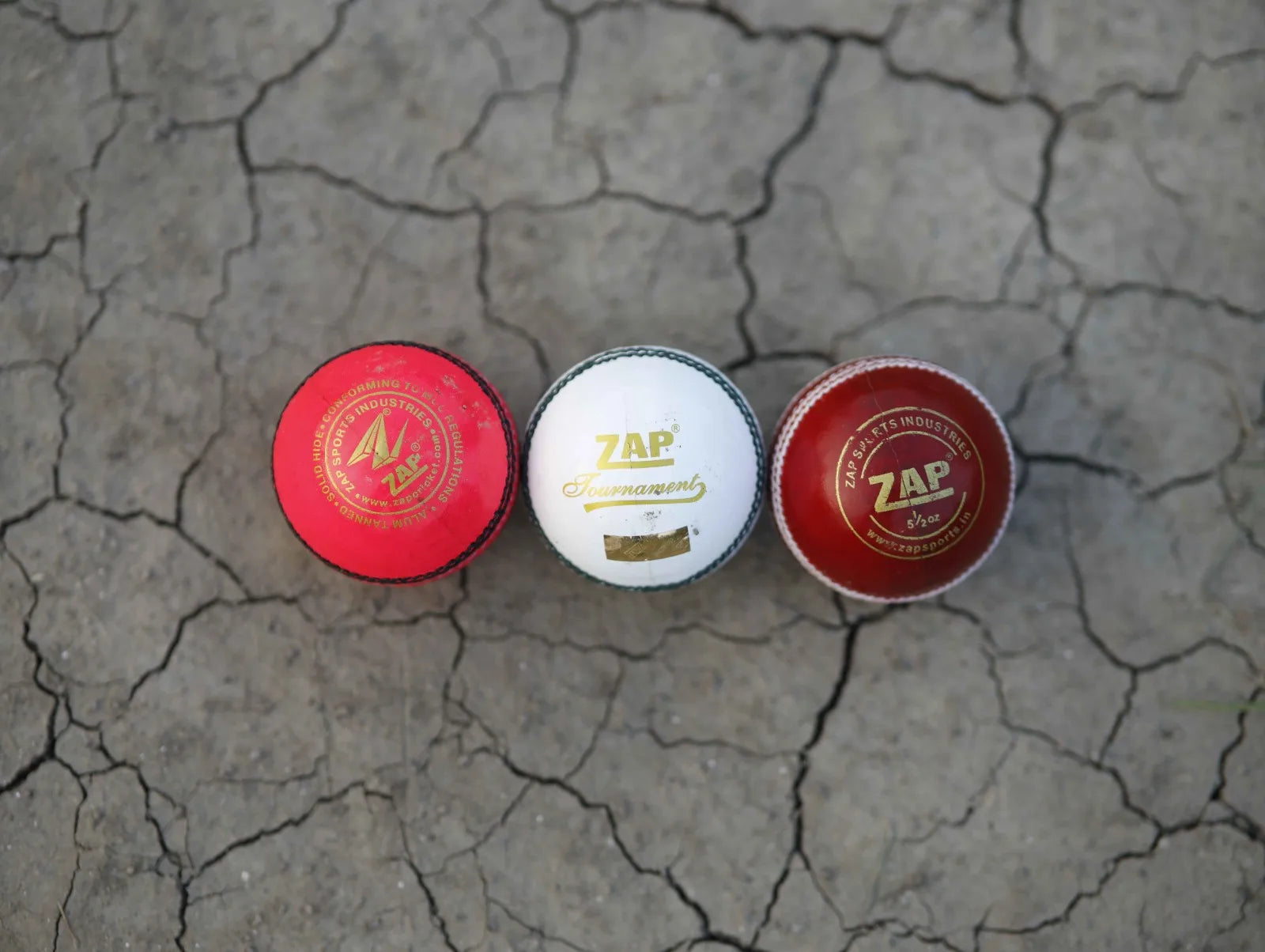You must all have seen the change in playing conditions in each format of the game, be it the test format or any white ball format. It is evident that the rules and format themselves influence how players play the game. The batters have to take up a more defensive game and play slower in test matches as compared to the limited-overs game, where they take more risks to score runs quickly. But what about bowlers, and how does their advantage change with each changing format? The answer is in the leather balls that are used in each format Test Cricket Format uses a red or pink leather cricket ball, while other limited overs format use a while leather ball. But what is the difference between each ball and how does it influence the game?

In this article by ZAP, let’s find out the difference between the Red, White and Pink Leather Cricket Balls.
Differences Between the Red, White and Pink Leather Cricket Balls:

|
Aspect |
Red Cricket Ball |
White Cricket Ball |
Pink Cricket Ball |
|---|---|---|---|
|
Pigmentation |
Wax on leather gives it the characteristic cherry colour |
More polished, shinier than red ones |
PU-based coat to appear brighter |
|
Seam Material |
Purely synthetic |
Fully synthetic |
Mixture of linen and synthetic |
|
Seam Firmness |
Distinct and Crisp Seam |
Crisper and fully synthetic |
Mixture of synthetic and linen |
|
Performance |
Less swing compared to white and pink |
Swings more due to extra polish and smooth surface |
Swings even more than red and white |
|
Visibility |
Good visibility during daylight matches |
Offers improved visibility for all formats |
Enhanced visibility during for day night matches |
|
Weight |
Standard weight |
Slightly heavier than red and pink |
Lighter than the white one |
Materials Used:
Leather cricket balls are intricately crafted from three primary materials: cork, string, and leather. The core of the ball is formed from cork, providing the necessary rigidity. This cork core is tightly wound with high-quality string, shaping the spherical structure of the ball. The outer layer consists of four pieces of leather meticulously stitched together to create the ball's covering.
Dyeing Process and Colour Variations:
- Red Balls: Red leather balls are dyed with a red hue dye during the manufacturing process which gives them its striking cherry red colour, that shine bright under the sun in test matches.
- Pink Balls: Contradicting the manufacturing process of the red balls, Pink Leather Balls get their bright pink colour from the pigment applied to the surface which is then coated with a polyurethane (PU) layer to protect the surface from wear and tear.
- White Balls: White balls are made out alum tanned leather which is more resistant to wear and tear. It is then dyed white and polished to make it shinier that other two deliveries.
Checkout: ZAP Tournament Leather Ball | ZAP Test Leather Ball
Physical Characteristics and Variations:
- Weight and Coating: White cricket balls are marginally heavier than pink balls due to the protective coating applied to them. Pink balls, however, are lighter and less polished compared to the white ones.
- Visibility: White balls are most preferred for night matches because they exhibit better visibility under floodlights compared to red balls, which often appear yellowish. Pink balls are specially designed for day-night test matches, and offer superior visibility under floodlights.
- Build Quality: Red balls are renowned for their durability, lasting for a minimum of 80 overs in Test matches. White balls, although durable, are more suitable for limited-overs matches. Pink balls, however, are exceptionally durable and are suitable for both Test and limited-overs cricket.
Seam and Stitching Variations:
- Seam Colour and Material: Red leather balls have a seam entirely made of synthetic material, and are stitched using white thread. Pink balls, on the other hand, have a seam made of a blend of synthetic and linen and are stitched using black thread.
- Durability and Grip: The seam of the pink leather ball is firmer and more pronounced compared to the red cricket ball. This enhanced grip is advantageous for bowlers, particularly fast bowlers. Moreover, the linen in the pink ball's seam helps in absorption of dew, providing better grip in damp conditions.
Also Read: Fast Bowling Tips and Techniques
Usage in Different Conditions and Formats:
- Red Balls: Red leather cricket balls have been used in test and first class matches since the history of cricket due to the striking red appearance under sunlight. These balls offer excellent swing and bounce, especially in the initial 15 overs and then start reverse swinging usually beyond the 40th over.
- White Balls: These balls are designed for Twenty-20 and One-Day matches where high visibility under the floodlights is needed. Also the construction is such that they last the heavy power hitting by the batsman without changing the shape and size for at least 50 overs.
- Pink Balls: Pink cricket balls are specifically designed for Day-Night Test matches. They maintain excellent swing and bounce even after 40 overs, making them suitable for longer formats of the game.
Also Read: Swing Bowling Tips and techniques
Durability and Longevity:
- Red Balls: These balls are renowned for their durability and can last for a minimum of 80 overs in Test matches.
- White Balls: Although they are super durable and can withstand the insane hitting of the willow against them, white cricket balls decay faster than red balls.
- Pink Balls: These balls are exceptionally durable and can retain their colour for a longer duration. They are suitable for both Test and limited-overs cricket matches.
Visibility and Performance:
- Visibility: Pink balls offer superior visibility under floodlights compared to both red and white balls. White balls, on the other hand, stand out well on television during day-night matches.
- Performance: While red balls provide strong swing and bounce in the initial overs, pink balls maintain excellent swing and bounce even after 40 overs. White balls are known for their smooth swing and movement but lose their swing early.
FAQ:
What is the weight and size of international level leather cricket balls?
The MCC dictates the weight and according to them, when new, it should weigh between 5.5 and 5.75 ounces. The weight of a ball in grams is between 155.9 and 163 g and in kgs is around 0.1559 kgs and 0.163kgs.
Who invented the leather cricket balls?
The earliest manufactured leather balls are thought to have been produced between 1760 and 1841 by the Duke family in England.
Are cricket balls made of cow leather?
Typically, cowhide or cow leather is used to make cricket balls, although occasionally, buffalo or ox hide is also utilised.
Now that you have read about the difference between red, white and pink leather cricket balls, here are some more articles we recommend you to read about:
How to select the right tennis bat | English Willow vs Kashmir Willow | What goes inside a cricket kit bag



Share:
Megastar Meg Lanning - The GOAT of Women's Cricket?
Predicting India's Squad and Playing 11 for the 2024 ICC T20 World Cup
2 comments
Red ball
White, Pink or Red Leather cricket balls are all Alum tanned. Your information is wrong please correct it